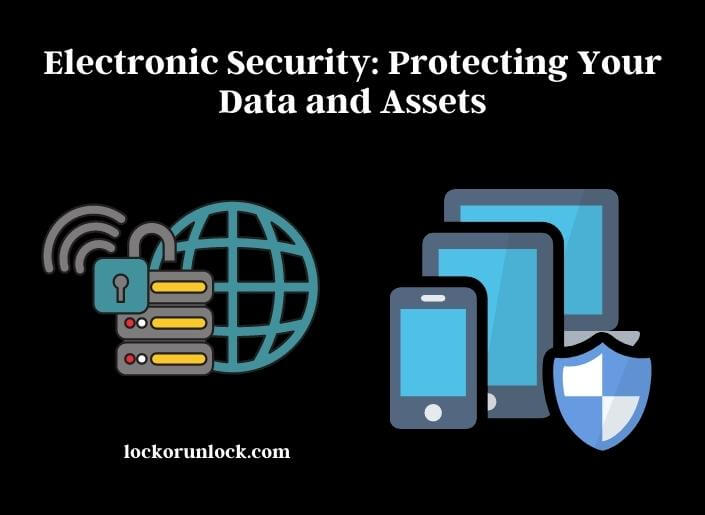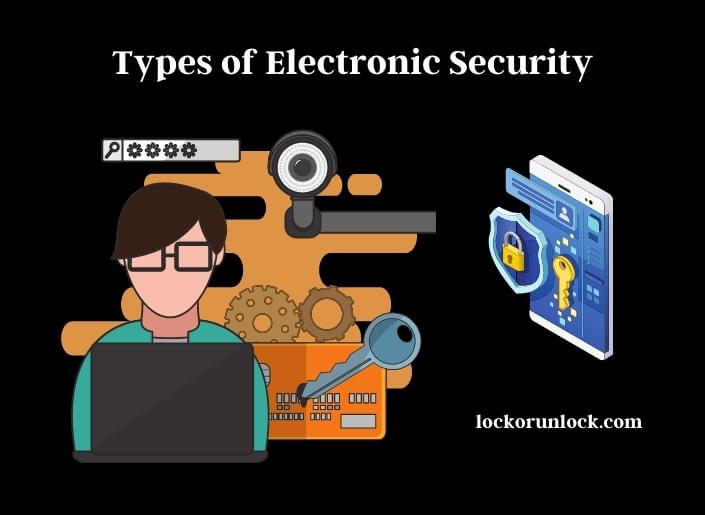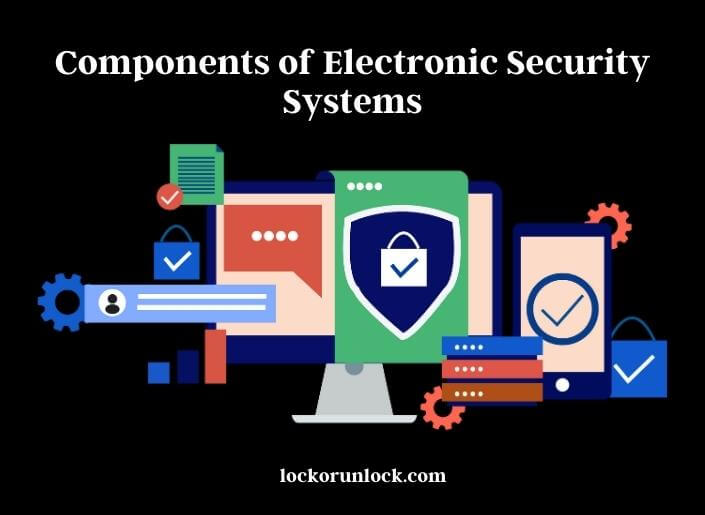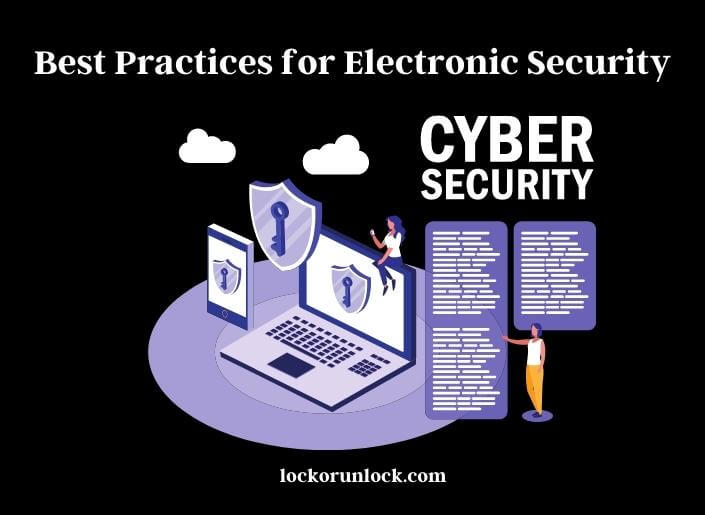With the rapid development of technology, electronic security has become increasingly important to protect sensitive data and assets from cyber threats. Electronic security refers to the measures taken to secure electronic systems, devices, and networks from unauthorized access, theft, damage, and other threats. It includes physical security measures, access control, network security, and data security.

In today’s world, electronic security is crucial for businesses, organizations, and individuals to protect themselves from cybercriminals who seek to exploit vulnerabilities in electronic systems.
A single security breach can result in severe financial and reputational damage, legal penalties, and loss of customer trust. Therefore, it is essential to have a robust electronic security system in place to ensure the safety and security of sensitive data and assets.
Electronic Security
Electronic security refers to the use of electronic systems and devices to protect people, property, and information from unauthorized access or intrusion. These systems can include a variety of technologies such as alarms, access control systems, video surveillance cameras, and biometric authentication devices.
The main goal of electronic security is to prevent security breaches by detecting and responding to potential threats in real-time. This is achieved through the use of advanced sensors and other technologies that can detect unauthorized access or suspicious activity, and then alert security personnel or authorities to take appropriate action.
Electronic security is used in a wide range of settings, from homes and small businesses to large corporations, government buildings, and public spaces such as airports and train stations. In addition to preventing theft and other criminal activity, electronic security can also help prevent accidents and injuries by monitoring hazardous areas and alerting people to potential dangers.
Types of Electronic Security
Electronic security systems are essential for protecting data and assets from cyber threats. There are several types of electronic security systems available, each designed to address specific security concerns. The four main categories of electronic security systems are physical security, access control, network security, and data security.

Physical Security
Physical security is the first line of defense against unauthorized access to buildings and sensitive areas. Physical security measures include CCTV cameras, motion detectors, and alarms. These systems provide visual surveillance and alert security personnel in the event of a breach.
Access Control
Access control systems limit access to specific areas of a building or network through keycards or biometric authentication. These systems allow only authorized individuals to access sensitive areas, such as server rooms or data centers. Access control systems can be used to monitor and track entry and exit times, providing valuable data for security audits.
Network Security
Network security involves protecting the network infrastructure from cyber threats such as viruses, malware, and hacking attempts. Network security systems include firewalls, intrusion detection systems, and intrusion prevention systems. These systems monitor network traffic, detect suspicious activity, and block unauthorized access attempts.
Data Security
Data security is about protecting the confidentiality, integrity, and availability of data. Data security measures include encryption, backup, and disaster recovery. Encryption ensures that data is secure when it is transmitted over a network, while backup and disaster recovery systems ensure that data can be recovered in the event of a disaster or security breach.
Each type of electronic security system has its features and benefits, and each is commonly used in different industries and settings. For example, physical security systems are widely used in retail stores and banks, while access control systems are common in hospitals and government buildings.
Network security and data security systems are essential in almost every industry and organization. By understanding the different types of electronic security systems available, individuals and organizations can choose the most appropriate systems to protect their data and assets.
Components of Electronic Security Systems
Electronic security systems typically include several components that work together to provide comprehensive security. These components can include sensors, alarms, cameras, locks, access control readers, firewalls, encryption tools, backup systems, and disaster recovery solutions.

Sensors and Alarms
Sensors and alarms are commonly used in physical security systems to detect intrusions or motion in restricted areas. These systems can trigger alarms or notifications to security personnel, enabling a quick response to a potential security breach.
Camera
Cameras are an essential component of electronic security systems, providing visual surveillance of areas that may be at risk. Security cameras can be used in both physical and data security systems, allowing security personnel to monitor and track activity within a building or network.
Locks and Access Control Reader
Locks and access control readers are used to restrict access to sensitive areas. These components can be integrated with keycards or biometric authentication to ensure that only authorized individuals are granted access to restricted areas.
Firewalls
Firewalls are an essential component of network security systems, providing a barrier between a network and the internet. Firewalls can prevent unauthorized access to a network and can be configured to block suspicious traffic, such as malware or viruses.
Encryption Tools
Encryption tools are used to protect data transmitted over a network or stored on a device. Encryption tools scramble data so that it is unreadable to unauthorized individuals, providing an additional layer of security to sensitive information.
Backup Systems and Disaster Recovery Solutions
Backup systems and disaster recovery solutions are essential components of data security systems. These systems ensure that data is backed up regularly and can be recovered in the event of a security breach or disaster. Disaster recovery solutions can be used to restore data and systems quickly in the event of a natural disaster or cyber attack.
Each component of an electronic security system plays a vital role in ensuring the safety and security of sensitive data and assets.
Electronic Security Threats
Despite the many benefits of electronic security systems, there are still several electronic security threats that individuals and organizations face. These threats can include both physical and digital attacks, and they can have severe consequences, including data loss, theft, and reputational damage.
Social engineering – Social engineering attacks involve using deception or manipulation to trick individuals into revealing sensitive information, such as passwords or account details. These attacks can be challenging to detect and can be used to gain access to sensitive data or systems.
Malware – Malware is malicious software designed to damage or disrupt computer systems. Malware can take many forms, including viruses, worms, and Trojan horses, and it can spread through email attachments, websites, or infected software.
Phishing attacks – Phishing attacks are another common electronic security threat, which involves sending fraudulent emails or messages to individuals in an attempt to obtain sensitive information. These attacks can be challenging to detect and can result in financial loss or identity theft.
Physical attacks – Physical attacks on electronic systems are also significant electronic security threats. These attacks can involve stealing hardware or breaking into a data center to gain access to sensitive information. Physical attacks can also include tampering with equipment or software, which can compromise data security.
To protect against electronic security threats, individuals and organizations need to implement best practices for electronic security. This can include training employees on how to detect and avoid social engineering and phishing attacks, using antivirus software and firewalls, and implementing access control and backup systems.
Best Practices for Electronic Security
Implementing best practices for electronic security is essential to protect against cyber threats. Here are some best practices that individuals and organizations can use to improve their electronic security:

Use Strong Passwords
Creating strong and unique passwords for all accounts is an essential step in electronic security. Passwords should be at least 12 characters long and include a combination of upper and lower-case letters, numbers, and special characters.
Keep Software Up to Date
Keeping software up to date is crucial for protecting against known vulnerabilities that can be exploited by cybercriminals.
Use Antivirus Software and Firewalls
Antivirus software and firewalls provide an additional layer of protection against malware and cyber-attacks.
Encrypt Sensitive Data
Encryption can prevent unauthorized access to sensitive data by scrambling it so that it is unreadable to anyone without the decryption key.
Limit access to sensitive data
Limiting access to sensitive data through access control measures, such as biometric authentication or keycard access, can help prevent unauthorized access.
Backup Data Regularly
Regularly backing up data is crucial to ensure that data can be restored in the event of a cyber-attack or disaster.
Train Employees on Electronic Security
Training employees on electronic security best practices, such as detecting social engineering and phishing attacks, can help prevent cyber-attacks and data breaches.
By implementing these best practices, individuals and organizations can significantly improve their electronic security and protect against cyber threats.
Benefits of Electronic Security
Electronic security refers to the use of electronic systems and devices to protect people, property, and information from unauthorized access or intrusion. Here are some benefits of electronic security:
Deterrence: Electronic security measures such as alarms, cameras, and access control systems can act as a strong deterrent against theft, vandalism, and other criminal activities. Criminals are less likely to target a property that has visible security measures in place.
Improved surveillance: Electronic security systems allow for continuous monitoring of a property, providing real-time alerts when there is any suspicious activity. This enables security personnel to respond quickly to potential threats and prevent security breaches.
Remote access: Electronic security systems can be accessed remotely, allowing authorized personnel to monitor a property from anywhere in the world. This is particularly useful for businesses with multiple locations or for those who travel frequently.
Protection of data: Electronic security measures such as firewalls, antivirus software, and encryption can protect sensitive information and data from cyber threats such as hacking and data breaches.
Enhanced safety: Electronic security systems can help prevent accidents and injuries by monitoring hazardous areas and alerting people to potential dangers.
Cost-effectiveness: Electronic security systems can be more cost-effective than traditional security measures such as physical security guards, as they require less manpower and can provide 24/7 surveillance.
Electronic security provides a range of benefits for individuals and businesses alike, helping to protect against a wide range of security threats and providing peace of mind.
If you want to know about Kwikset Locks. Read the article to learn this.
Last Point
In today’s digital age, electronic security is more critical than ever before. The use of electronic security systems can help protect sensitive data and assets from cyber threats, including social engineering, malware, and phishing attacks.
The different components of electronic security systems, such as sensors, alarms, cameras, locks, access control readers, firewalls, encryption tools, backup systems, and disaster recovery solutions, is crucial to ensure comprehensive security.
Implementing best practices for electronic security, such as using strong passwords, keeping software up to date, using antivirus software and firewalls, encrypting sensitive data, limiting access to sensitive data, backing up data regularly, and training employees on electronic security, is essential to protect against cyber threats.

Thanks for the sensible critique. Me and my neighbor were just preparing to do some research about this. We got a grab a book from our local library but I think I learned more clear from this post. I am very glad to see such magnificent info being shared freely out there.